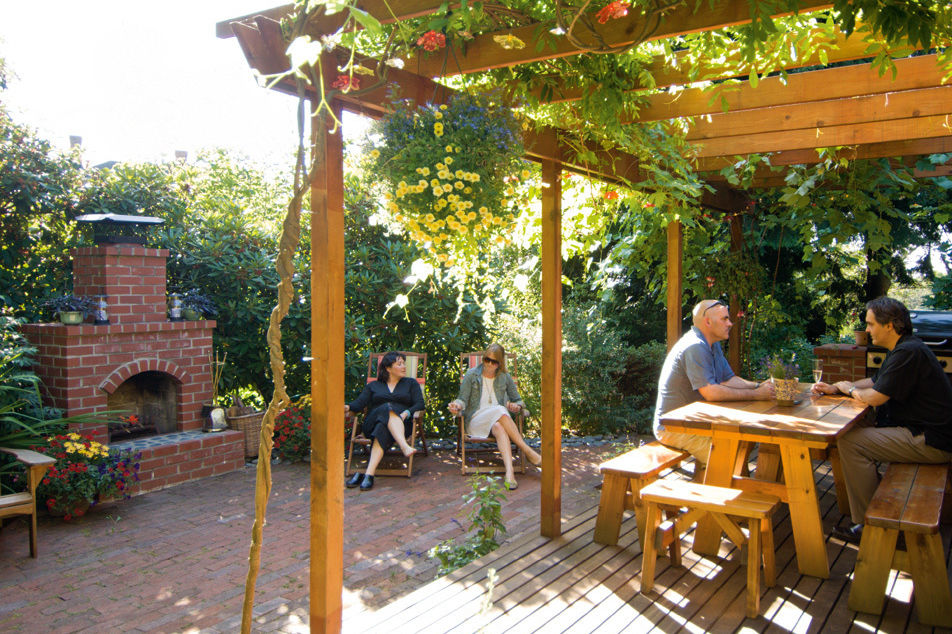Ocean Theater

Image: Bruce Wolf
FORMER PRO BASKETBALL player Dennis Awtrey lived in (and played for) Philadelphia, Chicago, Phoenix, Boston, Seattle, and Portland. But it took only a couple of visits to the Oregon Coast to persuade him and wife Peggy to move there—specifically, to the quiet beach town of Neahkahnie. As the couple searched for just the right house to accommodate Dennis’s retirement, their frequent entertaining, and Peggy’s paralegal telecommuting, they instead found a lot that Dennis still sighs over when he recalls seeing it for the first time: a tiny shelf on the plunging slopes of Neahkahnie Mountain.
The Awtreys’ lot can be found in the brushwork of many a painting of the mountain by Oregon artists. In the 1910s, when Portlanders could hop a train from downtown bound for the coast, Neahkahnie and Manzanita became a magnet for Stumptown’s emerging culturati. Portland Art Museum’s director, Annabelle Crocker, had a house, as did Multnomah County library director Mary Frances Isom (which library employees can still sign up to use). Portland’s then-most-important architect, A.E. Doyle, designed a studio/house for prominent artist/teacher Harry Wentz just steps away from the Awtreys’ lot. It became a key inspiration to a young Pietro Belluschi and John Yeon, who hatched the Northwest Regional style of architecture.
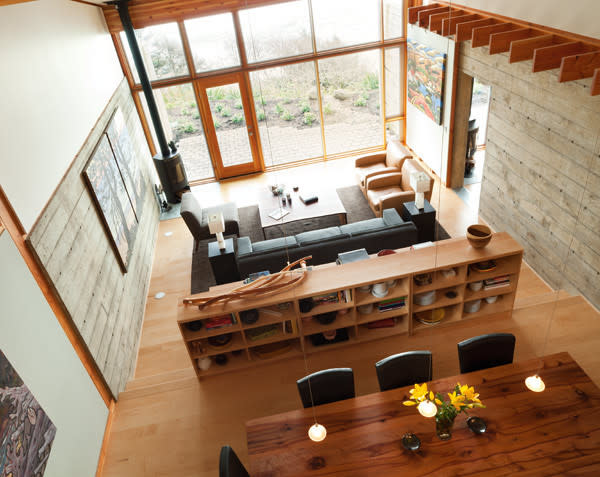
The shared living space for the Awtreys and their guests.
Image: Bruce Wolf
The Awtreys knew little of that history. But the site and simple grace of Manzanita and Neahkahnie inspired them both to build a bed-and-breakfast and to think carefully about who should design it. A glimpse of a Lopez Island house overlooking the Strait of Juan de Fuca in Sunset magazine fostered another dream: hiring its architect, James Cutler of the Bainbridge Island–based Cutler Anderson Architects. But given his résumé (Cutler is widely known as a codesigner of Bill Gates’s Medina, Washington, compound, plus other iconic homes in places as diverse as the Napa Valley, Majorca, and Australia), they dismissed the idea—until a friend encouraged them to try. One phone call and one transfer later, and Jim Cutler was on the line.
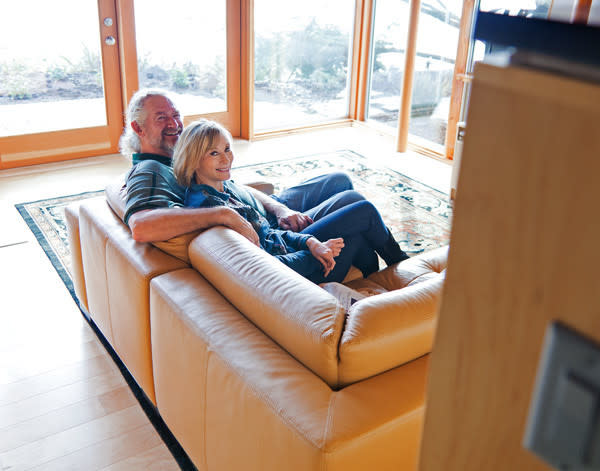
The Awtreys in their den.
Image: Bruce Wolf
From famed houses to über-sustainable Seattle public library branches to the Edith Green-Wendell Wyatt Federal Building now under construction in downtown Portland (a major remodeling of an office high-rise he has led in collaboration with Sera Architects), Cutler’s designs aren’t driven by style; they’re all about site. The Awtreys’ land instantly captivated him, too, with its views of the gently curving beach to the south, the deep ocean horizon to the west, and local surfing hot spot Smuggler’s Cove to the north.
“That place is ferocious,” Cutler says of the wind and rain that can pummel the cliffs. But the steepness, he quickly concluded, allowed for a house completely protected from neighboring properties. “It had the potential for spectacular intimacy with the ocean,” he says.
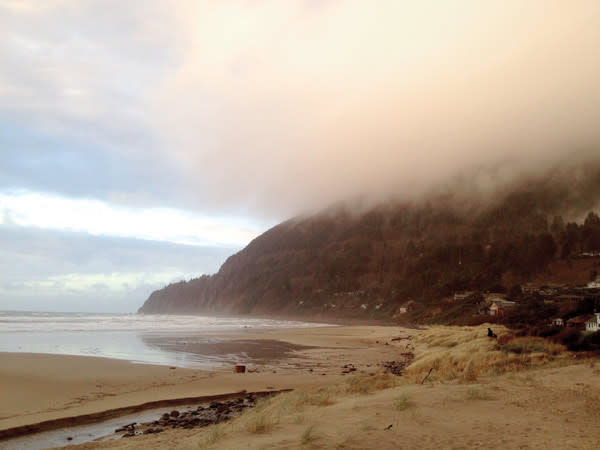
Neahkahnie Mountain
Image: Randy Gragg
The Awtreys wanted their B&B to offer plenty of openness when rooms were filled with visiting family or guests who wanted to socialize, but privacy for visitors who craved it. For Cutler, a key driver was transforming the brutal weather into “entertainment” by making a setting so safe and solid it wouldn’t even so much as creak in the wind. “You want a building that feels like it’s really dug in,” he says, “so you can feel warm and comfortable and actually enjoy the storms.”
Cutler’s solution is as rugged as it is simple: five stout concrete walls that divide the building into zones—two B&B units, the entertaining/dining rooms, and the more private complex of kitchen, den, and master suite. Every other feature of the house is articulated in little more than wood and glass, creating a transparency that allows views to the ocean from almost every room. A low-pitched metal roof slopes toward the sea, as Cutler describes it, “like a baseball hat pulled down to protect your face from the rain,” with the only break being one dormer, rising like another brim for the master suite’s ocean view.
{page break}
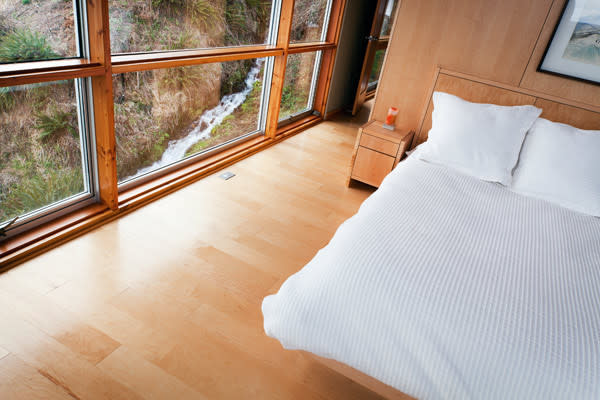
The master suite enjoys spectacular views of both the ocean and a creek below.
Image: Bruce Wolf
As with all Cutler designs, the grace lies in the procession into and through the house. The entry path from the parking area to both the B&B units and the front door is pulled back from the cliff edge, so the ocean can only be heard. When the landscape matures, the entry will be tunnel-like, with lush ferns at foot and tree bows overhead. The foyer is so small it feels almost pinched. But turn the corner into the main rooms, and the view explodes. So, too, with the cleverly designed B&B units, where the suites offer their expansive vistas both from the bed, and, if the bathroom’s shutters are flung open, from a two-person soaking tub.

Cutler’s “compression” of the entryway, which leads to the “expansion” of the views.
Image: Bruce Wolf
Cutler believes no feature is too large or small for painstaking consideration or to be fully revealed. The roof’s exposed eaves reveal intricately cut truss ends held in place by galvanized pipes. The drywall is pulled back from the ceiling and floor to expose the finished studs behind. The door levers are a smooth laminate of brushed steel and wood specially manufactured by Reveal Designs in partnership with Cutler. The concrete walls—board-formed with eight-inch rough planks in tan and green tints added to the mix—are almost entirely visible, inside and out. Both rugged and warm, Cutler notes, “The concrete shows that human hands made it.”
Surprisingly, despite all his tony landmark commissions, Cutler says he takes 90 percent of the house commissions offered him. “The clients who call,” he says, “generally know our principles. The budgets can range from “the millions to $500,000.” The smaller square footages (the Autreys’ was only 3,100 with the two B&B units), he adds, are “way more fun, because they can be more lyrical.”
The Awtreys chuckle that they “had no understanding of how radically different this house was.” Dennis recalls an early epiphany when he realized the contractor had to sort through hundreds of 16-foot two-by-fours to find ones that were straight and clear enough to look good exposed. Peggy remembers sending the architect worried interrogations about details she didn’t like after visits during construction. Cutler’s friendly reply: “Don’t worry. It’s going to look great.”
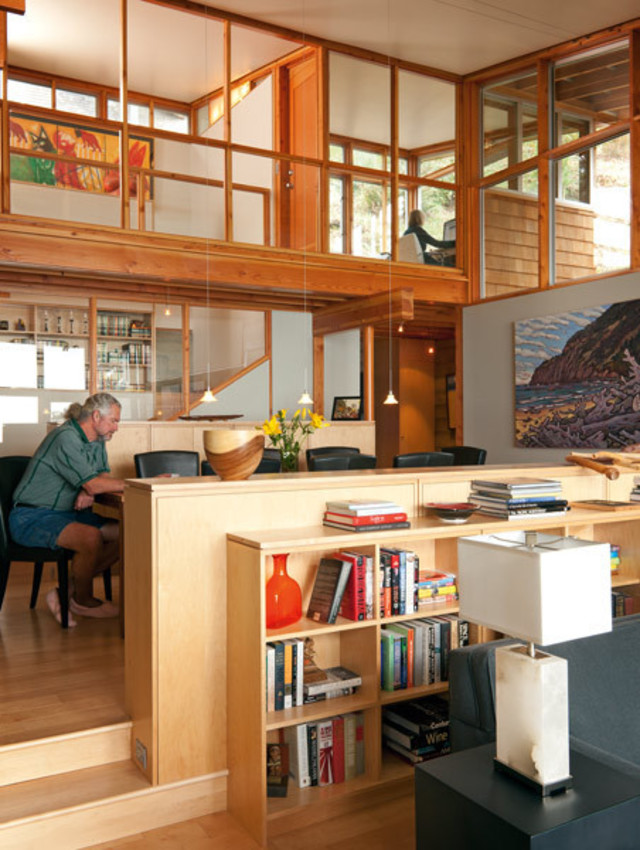
Glass interior walls keep the house open and airy.
Image: Bruce Wolf
Dennis’s high-design appetite had always been for cars: a Porsche Carrera RS and a trio of Ferraris—a 1971 Daytona Spyder, a 1958 250 GT, and a 1967 330 GTC. With unexpected delays due to B&B permitting, unplanned costs for stabilizing the hillside, and their original contractor going bankrupt during the recession (Dennis himself oversaw the B&B’s final phase), he quips that he traded in the cars for the house. “Your life has different phases,” he shrugs, describing a typical day of watching storms passing, eagles soaring at eye level, and deer sipping at the adjacent creek. The B&B, the Awtreys say, is a good way to combat the coast’s isolation, and also an opportunity to share.
“There’s only one other place in the world you can stay in a Jim Cutler design,” he says with a grin, “and that’s in Ketchikan, Alaska.”
For more information on the Awtrey House bed-and-breakfast, visit awtreyhouse.com.
High Craft High Rise
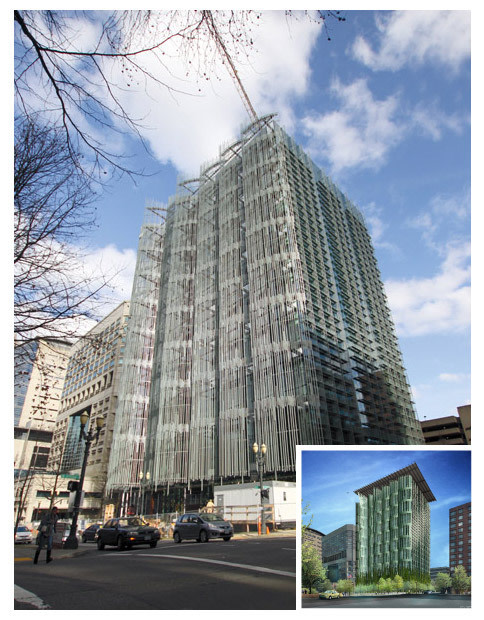
Photo: Courtesy SERA Architects
FOR THE EDITH Green-Wendell Wyatt Federal Building, now under reconstruction in downtown Portland, James Cutler applied a similarly bold, meticulous approach to form and craft as he did in the Awtrey B&B. Working with Portland’s Sera Architects and the world-renowned Portland-based curtain wall manufacturer Benson Industries, Cutler developed the building’s curving, cantilevering, west-facing sunshades. Designed to block more than 50 percent of the building’s solar heat gain, the simple, square “reeds” are arrayed into seven repeating patterns for a random, organic feel. A mix of evergreen vines—among them, Silver Vein Creeper, Chocolate Vine, and Madison’s Star Jasmine—will climb as high as 40 feet to, as Cutler describes it, “wed the building to the ground.”
The same board-formed concrete Cutler used to such striking effect in the Awtreys’ home will appear at the base of the building and in the plaza. Cutaways of the old concrete floors will send daylight streaming between the original giant beams into the gym, meeting rooms, and dining hall in the basement.
“It’s a remodel,” Cutler says matter-of-factly. “We’re exposing the work of the people who made it—the sense of history and time and humanity.”



